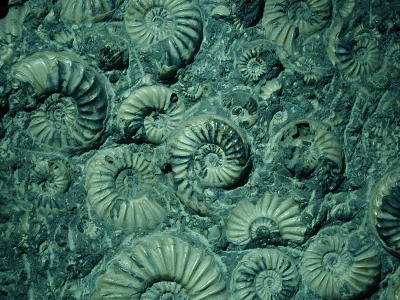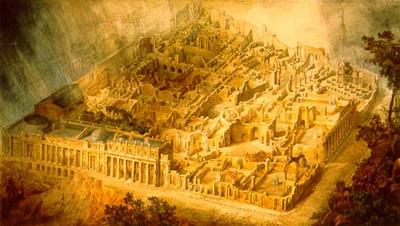Urban fossil value
As Hurricane Rita carves away at the Gulf shore, Galveston burns, buses explode outside Houston, and New Orleans refloods through badly built and incompletely repaired levees, I stumbled upon an old article, from 1998, about fossilized cities.
Millions of years from now, in geographical regions "entombed by tectonic disturbances," entire cities – "the abandoned foundations, subways, roads and pipelines of our ever more extensive urban stratum" – will actually come to form "future trace fossils."
These "future trace fossils," the article says, form easily preserved systems that are "a lot more robust than [fossils] of the dinosaurs. They include roads, houses and foundations."
And yet, for all that, only those cities "that were rapidly buried by floods or sandstorms" will be "preserved for posterity."
Los Angeles, for instance, "is on an upward trajectory, pushed by pressure from the adjacent San Andreas Fault system, and is doomed to be eroded away entirely." But if a city is flooded, buried in sand, or otherwise absorbed downward, "the stage is set to produce ideal pickling jars for cities. The urban strata of Amsterdam, New Orleans, Cairo and Venice could be buried wholesale – providing, that is, they can get over one more hurdle: the destructive power of the sea."
It is often remarked in architectural circles how megalomaniacal Nazi architect Albert Speer came up with his so-called theory of ruin value, in which he proposed a new Romano-Fascist Berlin designed to look good as a ruin in thousands of years.
But that's boring – let's talk about cities fossilizing over millions of years.
Urban fossil value.
The already buried, subterranean undersides of our Tube-hollowed, war-bunkered modern cities "will be hard to obliterate. They will be altered, to be sure, and it is fascinating to speculate about what will happen to our very own addition to nature's store of rocks and minerals, given a hundred million years, a little heat, some pressure (the weight of a kilometre or two of overlying sediment) and the catalytic, corrosive effect of the underground fluids in which all of these structures will be bathed."
Who knew, for instance, that plastics, "which are made of long chains of subunits, might behave like some of the long-chain organic molecules in fossil plant twigs and branches, or the collagen in the fossilized skeletons of some marine invertebrates"? Who knew, in other words, that plastics will fossilize?

Indeed, "with a favourable concatenation of tectonics and sea level, our species could leave behind in a geological instant a much more striking record than the dinosaurs left in a hundred million years."

[Image: J.M. Gandy, speculations toward the ruins of John Soane's Bank of England – but, again, how about speculations toward the Bank of England's fossils...?]
Millions of years from now, in geographical regions "entombed by tectonic disturbances," entire cities – "the abandoned foundations, subways, roads and pipelines of our ever more extensive urban stratum" – will actually come to form "future trace fossils."
These "future trace fossils," the article says, form easily preserved systems that are "a lot more robust than [fossils] of the dinosaurs. They include roads, houses and foundations."
And yet, for all that, only those cities "that were rapidly buried by floods or sandstorms" will be "preserved for posterity."
Los Angeles, for instance, "is on an upward trajectory, pushed by pressure from the adjacent San Andreas Fault system, and is doomed to be eroded away entirely." But if a city is flooded, buried in sand, or otherwise absorbed downward, "the stage is set to produce ideal pickling jars for cities. The urban strata of Amsterdam, New Orleans, Cairo and Venice could be buried wholesale – providing, that is, they can get over one more hurdle: the destructive power of the sea."
It is often remarked in architectural circles how megalomaniacal Nazi architect Albert Speer came up with his so-called theory of ruin value, in which he proposed a new Romano-Fascist Berlin designed to look good as a ruin in thousands of years.
But that's boring – let's talk about cities fossilizing over millions of years.
Urban fossil value.
The already buried, subterranean undersides of our Tube-hollowed, war-bunkered modern cities "will be hard to obliterate. They will be altered, to be sure, and it is fascinating to speculate about what will happen to our very own addition to nature's store of rocks and minerals, given a hundred million years, a little heat, some pressure (the weight of a kilometre or two of overlying sediment) and the catalytic, corrosive effect of the underground fluids in which all of these structures will be bathed."
Who knew, for instance, that plastics, "which are made of long chains of subunits, might behave like some of the long-chain organic molecules in fossil plant twigs and branches, or the collagen in the fossilized skeletons of some marine invertebrates"? Who knew, in other words, that plastics will fossilize?

Indeed, "with a favourable concatenation of tectonics and sea level, our species could leave behind in a geological instant a much more striking record than the dinosaurs left in a hundred million years."

[Image: J.M. Gandy, speculations toward the ruins of John Soane's Bank of England – but, again, how about speculations toward the Bank of England's fossils...?]

Comments are moderated.
If it's not spam, it will appear here shortly!
Alongside fossils, airtight subterranean passages will, given vast spans of geological time, become CRYSTAL CAVERNS, immense geodes of infinitely varied formations...
Post a Comment